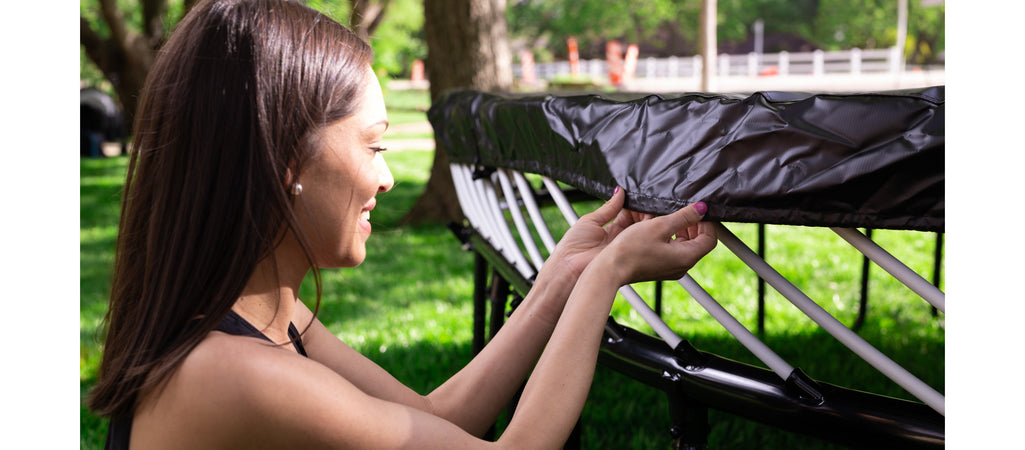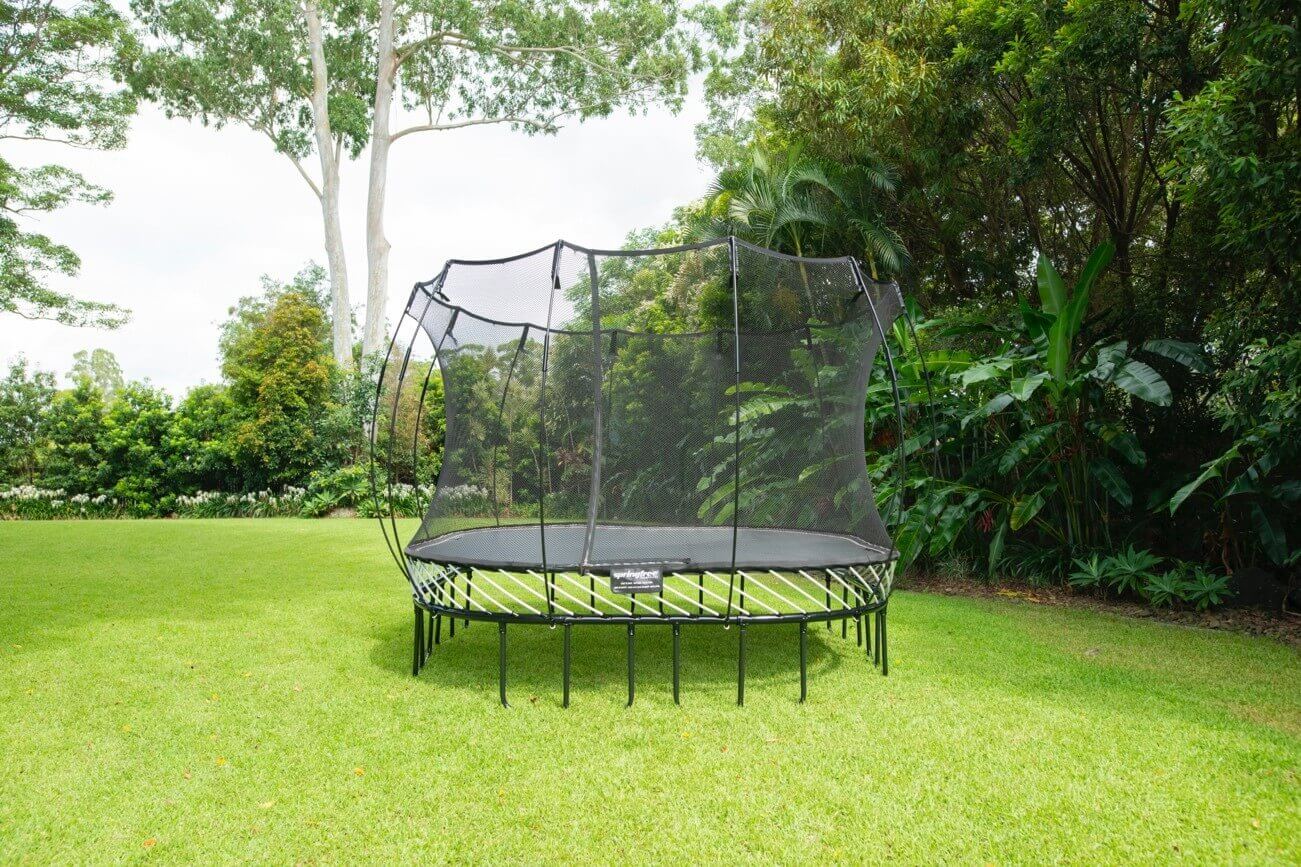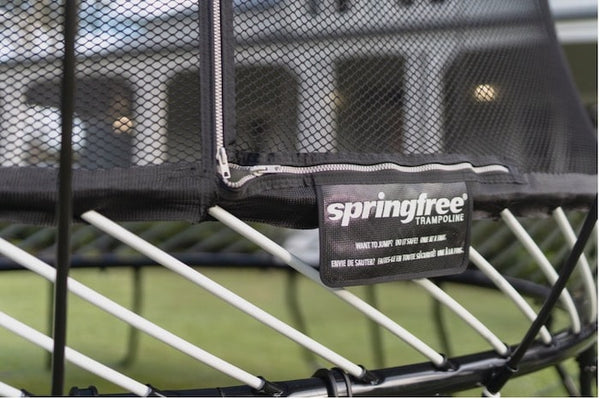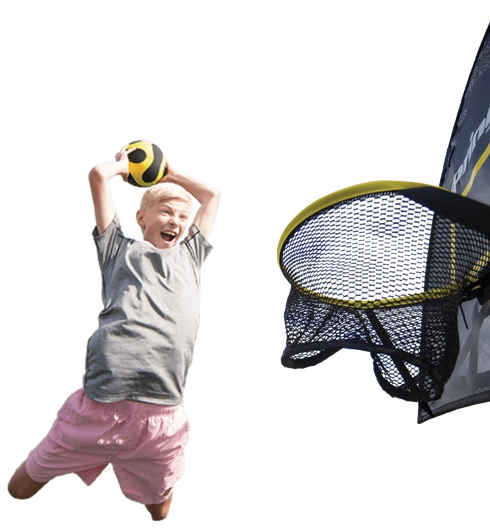Spring vs. Springless Trampolines—Which One Is Better?
In this article, we explore spring-based and springless trampolines, the two outdoor trampoline designs, to help you make the right decision for your backyard.
min read

When buying an outdoor trampoline, there are two main types of trampolines you can choose from: Spring or springless.
There are major differences between spring-based trampolines and springless trampolines.
We at Springfree Trampoline (the creators of the springless design) want to make sure you have all the facts on this crucial subject.
But just because we pioneered and sell springless trampolines doesn’t mean we’re going to irrationally favor them over spring-based trampolines.
The truth is, there are pros and cons to both, and you’re going to learn about the ones you need to know most in this article. And it will be done from an accurate, fair and transparent approach.
What Are Spring Trampolines?
If you had an outdoor trampoline as a child and were born before the 2000s, then you almost certainly grew up with a spring trampoline.
Fundamentally, spring trampolines use metal springs to connect the jumping mat to the frame and it is the system that provides the bounce for traditional trampolines.
Initial porotypes of spring trampolines were invented in the early 20th century by gymnasts George Nissen and Larry Griswold at the University of Iowa.
They gained popularity as the decades went on, and soon become a staple in backyards for kids that wanted a fun way to burn energy.
Today, spring trampolines are still the most common type of backyard trampoline and are offered by many brands, including, JumpSport, Skywalker and Acon, among many others.

Photo courtesy of Skywalker Trampolines.
What Are Springless Trampolines?
Springless trampolines are an alternative to the traditional trampoline and were introduced to the marketplace in the early 21st century.
As you can guess by the name, they stray away from using springs as the main infrastructure for the trampoline’s bounce.
Instead, springless trampolines use materials like composite rods, bungee chords or elastic straps as replacements for springs.
An example of a springless trampoline:

Springless trampolines were created by Dr. Keith Alexander in the early 2000s with the goal of creating “the safest trampoline and elevating trampoline safety around the world.”
Trampolines without springs have become more popular among households as the 2000s have rolled on and even other brands, like Vuly and Kahuna (both Australian-based), have joined in making their own springless trampoline models.
Currently, Springfree Trampoline is the only brand that sells springless trampolines and maintains a strong presence in North America.
5 Key Differences Between Spring and Springless Trampolines
Now that you have working definitions of spring and springless trampolines, let’s get into the main differences between the two:
-
Design
The primary difference between spring and springless lies in the design of the trampoline.
Since we already went over the definitions of both, we won’t expand too much on this section, but to recap:
Spring trampolines use springs as the primary system to get the bounce and springless trampolines use other materials—like composite rods or bungee cords-- as its chief infrastructure to get the bounce.
The design of the trampoline also plays a role in the aesthetics of the trampoline.
Although beauty is subjective, springless trampolines tend to be more visually pleasing than traditional trampolines, although this will depend on the exact type you’re talking about.
-
Safety
The design of the two trampolines is the fundamental difference, but so many factors are affected by the design—most chiefly, safety.
The idea behind springless trampolines is to make trampoline jumping safer by getting rid of the springs and replacing them with rods positioned under the jumping surface that separate the hard frame from the jumper. stronger, sturdier materials.

Metal springs can cause pinching injuries to toes, feet or hands, and falling on springs creates the potential for more serious injury.
This is the basic premise behind the general truth that springless trampolines are much safer than spring trampolines, especially when talking about cheaper spring trampolines.
Beyond the springs, springless trampolines also tend to have better overall safety features.
For example, Springfree Trampolines include features like a hidden frame, FlexiNet, which is held by flexible enclosure rods and the SoftEdge mat that covers the area where the rods meet the mat and is 30x more cushioned than traditional safety pads.

-
Bounce Quality
The next difference revolves around the bounce—a synonymous feature of all trampolines.
With spring trampolines, the bounce is created by the springs stretching and then recoiling when jumped on. Springless trampolines use other means, like flexible rods, that lie beneath the jumping surface to create the bounce.
It’s arguable which type of trampoline provides the better bounce because it depends on the trampoline you’re talking about.
Because of the tension of the springs, some spring-based trampolines (especially on the expensive end) may provide a slightly higher bounce than springless trampolines.
However, springless trampolines tend to provide a softer, more consistent bounce that is easier on your joints.
-
Durability and Maintenance
The fourth difference is an important one because it involves how long the trampoline will last and how much maintenance it will need to upkeep properly.
The springs on a trampoline are more susceptible to rust and deterioration than the rods on springless trampolines.
Because of this, the rods tend to last longer than springs. For example, our Springless Trampolines, assuming best jumping practices are followed, should last at least 10 years with the solid bounce still intact.
It’s much more difficult for a spring trampoline to last that long because metal springs are more vulnerable to aging and weather-related damage, especially on cheaper models.
Maintenance can also be a pain point for spring trampolines. For instance, on a typical traditional trampoline, you will likely need to change the safety padding around the springs at least once a year if the trampoline is used frequently.
Since springless trampolines are usually built with stronger material, the need to buy replacement parts becomes significantly less and basic trampoline cleaning is usually all that is required to conserve the trampoline.
-
Price
The final difference between springless and spring trampolines revolves around pricing.
Because springless trampolines tend to be safer and of higher quality, while still providing a similar bounce, they will be more expensive than a spring trampoline in most cases.
This, of course, will depend on the type of trampoline you’re talking about. Let’s demonstrate this by listing out four trampolines that differ in quality, and thus, price point:
-
Skywalker 12 ft Round Trampoline (Low quality, springs) - $350
-
JumpFlex Hero120 12 ft Trampoline (Good quality, springs)- $849
-
Springfree Large Square 11 ft Trampoline (High quality, springless) - $1,999
-
JumpSport AlleyOOP 12 ft Trampoline (High quality, springs) - $2,149
As the quality goes up, so does the price. Trampolines are just like clothes, cars or food in that way: You can get a lower quality trampoline for a cheaper price or a higher quality trampoline for a more expensive price.
It all comes down to your goals and how much you’re willing to pay for a trampoline.
Who Would Be a Fit for a Spring Trampoline?
Now that we’ve looked at five essential differences between the two types of outdoor trampolines, let’s sum up who would be a fit for each, starting with spring trampolines.
You would be a fit for a trampoline with springs if:
-
You want to purchase a cheap or medium-priced trampoline.
-
You want a trampoline for short-term use (i.e. you don’t think your child will use it for long).
-
You want more trampolines to choose from (most trampoline brands sell spring-based trampolines)
-
You prefer the trampoline-with-springs look over the springless style.
Who Would Be a Fit for a Springless Trampoline?
On the other hand, you would be a fit for a springless trampoline if you meet the following criteria:
-
You want the safest type of trampoline for your family.
-
You want the highest quality trampoline that will last for the long haul.
-
You want a trampoline that is weather-resistant and requires less maintenance.
-
You prefer the springless trampoline look.
Which Trampoline Is Right for You?
The type of trampoline you buy, either with springs or without springs, affects so many other factors like safety, quality, bounce, durability maintenance and price.
Ultimately, it’s up to you to decide which trampoline type is ideal for you. Our advice as a trampoline innovator and manufacturer is to ponder both options and see what’s out there before purchasing.
Once you get to the point where you know exactly the type of trampoline you want, you’re ready to start zeroing in on specific trampoline models.
What’s the best way to narrow down your list, though? After all, there are hundreds of trampolines you can buy, and it can be overwhelming to individually go through each of them, hoping to stumble across the right one.
We have just the resource for you: Our Ultimate Trampoline Buying Guide.
This Guide will help you formulate your goals and should lead you well on your way to buying the trampoline that will provide your family with plenty of joyful moments in the future.

